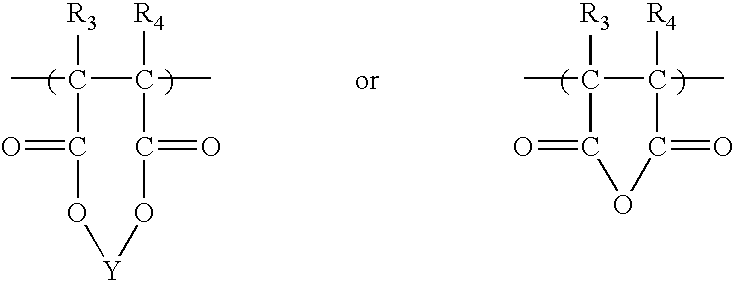Anti-explosive fertilizer coatings
a fertilizer coating and anti-explosion technology, applied in the field of coatings, can solve the problems of releasing considerable amounts of energy and leaving numerous pores exposed, and achieve the effects of reducing hydrocarbon infiltration, limiting hydrocarbon infiltration of fertilizer particle pores, and reducing hydrocarbon infiltration
- Summary
- Abstract
- Description
- Claims
- Application Information
AI Technical Summary
Benefits of technology
Problems solved by technology
Method used
Image
Examples
example 1
[0042]In this example, agricultural grade ammonium nitrate particles were coated with various polymeric materials, as set forth in Table 1, and then exposed to diesel fuel. The amount of diesel fuel retained by the coated particles compared to the original amount of diesel fuel added was then determined.
[0043]The ammonium nitrate particles were coated with the respective polymers according to one of the following two procedures. The most typical procedure was to weigh out an amount of the polymer solution to be coated onto a petri dish having a diameter of about 90 mm. All polymer solutions used in this experiment contained 50% by weight polymer. An appropriate amount of ammonium nitrate particles were weighed out and rolled onto the petri dish. The dish was then covered and the particles were vigorously swirled across the coating materials for several minutes. An alternative coating procedure was to weigh out an appropriate amount of ammonium nitrate particles and place them into a...
example 2
[0056]The purpose of this example was to optimize diesel fuel resistance of two-component coatings. In these experiments, porous paper, S&S paper type #404 (Schleicher & Schuell, Dassel, Germany), was used to simulate porous ammonium nitrate particles. Upon examination using a low-power microscope, the porous paper had generally similar porosity to that of high porosity ammonium nitrate. The porous paper had the added advantage of being of substantially uniform porosity whereas the ammonium nitrate granules were of varying shape and porosity.
[0057]In the first experiment, the optimal percent of polymer solids in a coating was determined. The polymer coatings tested were polymaleic acid, sodium polymaleate at pH 3.5, itaconic acid homopolymer, polyacryilc acid, and BC acid polymer. The coating was applied to an 80×80 mm area on a sheet of porous paper by placing small drops of aqueous coating solution to the paper and spreading them to cover the test area using an inert plastic ruler...
example 3
[0060]In this example, an alternative method of applying the polymer coating to the fertilizer particles was explored. The method involved placing a piece of flat round filter paper (S&S paper type #404) into a 5.5 inch diameter petri dish so that the paper occupies the entire bottom of the dish. About 2.9 g of the 20% w / w solution prepared in Example 2 is spread onto the paper until the paper is saturated with the liquid, but not to the point where there is liquid on the paper surface. The filter paper should be slightly moist to the touch. About 13 g of ammonium nitrate particles are poured onto the paper surface and rolled around the petri dish for about 1 minute, then removed. The particles are allowed to dry for 15 minutes in the air. This method was found to be highly effective as particles coated using this method do not tend to stick together and are dry and smooth to the touch.
[0061]Any method of particle coating known in the art, such as spraying, may be employed to apply ...
PUM
| Property | Measurement | Unit |
|---|---|---|
| Percent by mass | aaaaa | aaaaa |
| Percent by mass | aaaaa | aaaaa |
| Percent by mass | aaaaa | aaaaa |
Abstract
Description
Claims
Application Information
 Login to View More
Login to View More - R&D
- Intellectual Property
- Life Sciences
- Materials
- Tech Scout
- Unparalleled Data Quality
- Higher Quality Content
- 60% Fewer Hallucinations
Browse by: Latest US Patents, China's latest patents, Technical Efficacy Thesaurus, Application Domain, Technology Topic, Popular Technical Reports.
© 2025 PatSnap. All rights reserved.Legal|Privacy policy|Modern Slavery Act Transparency Statement|Sitemap|About US| Contact US: help@patsnap.com



